NUR 6345 - Polypharmacy and Fall Risk in Elderly: An EBP Project
VerifiedAdded on 2023/04/07
|12
|1837
|138
Report
AI Summary
This evidence-based practice project examines the correlation between polypharmacy (the use of four or more medications) and the increased risk of falls in elderly patients aged 65 and older. It addresses the PICOT question of whether taking four or more medications, compared to three or fewer, impacts the risk of falls over a three-month period. The report identifies gaps in the literature and explores potential strategies to mitigate fall risk, including proper medication prescription assessment, implicit strategies for RNs, and the application of Orem's self-care deficit theory. The role of the RN in identifying patient perceptions and facilitating behavior change is highlighted, along with evidence-based programs and measurement tools like the Rapid Assessment of Physical Activity (RAPA) and the Karnofsky Performance Scale (KPS). The clinical setting of nursing care is deemed relevant for assessment and management, while threats to the project, such as nonspecific medication reviews and sedentary participants, are acknowledged. The project emphasizes the importance of individualized, longitudinal management and the need for further research on the effects of medications on mortality rates among the elderly. This project is relevant to APNs as it provides insights on the significance of health issue and the lack of inconsistency in practice to prevent fall and its management. The change in practice as an APN comes along with the use of tools and potential strategies recognised in EBP to reduce the occurrence of falls in the elderly or facilitation of provider compliance.
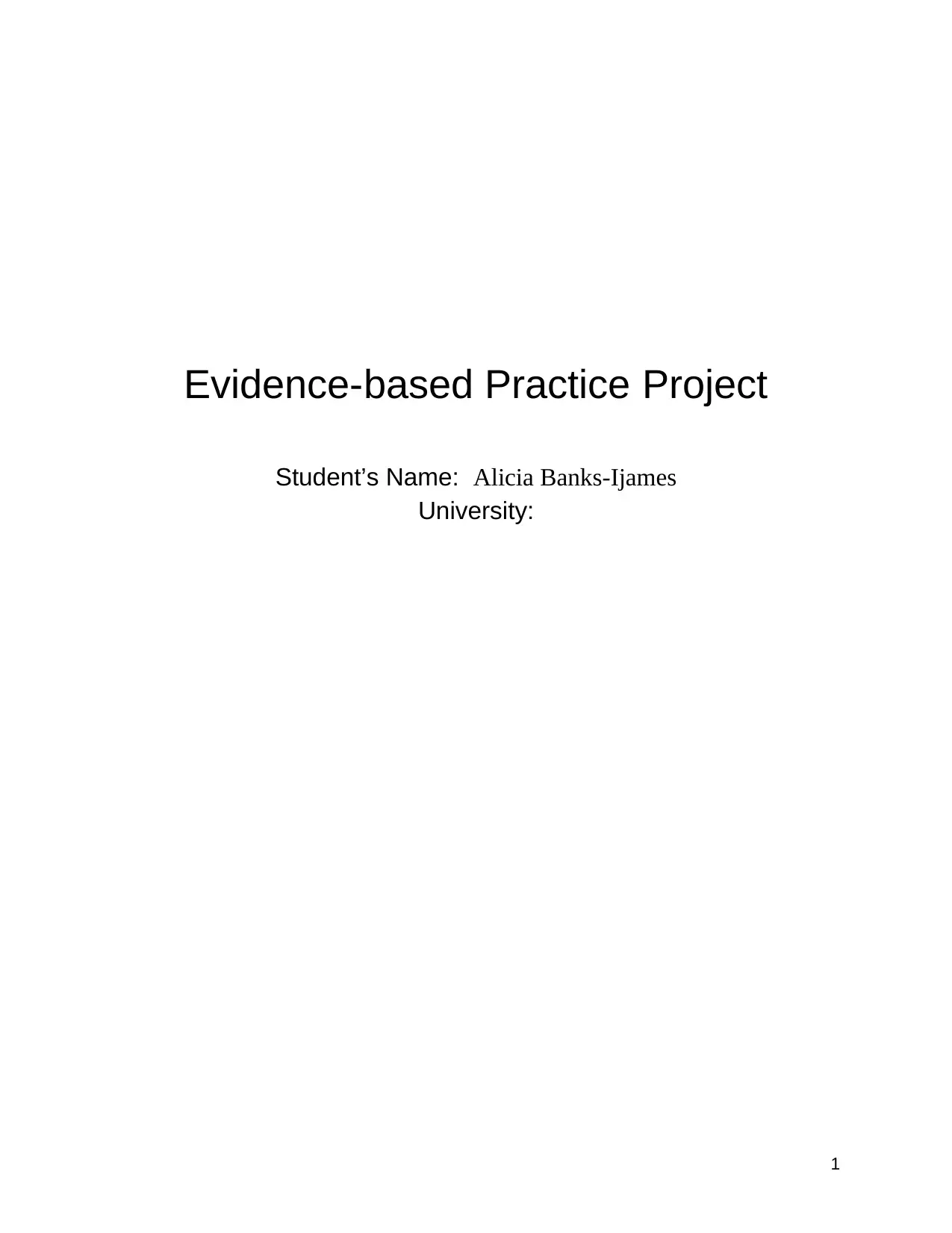
Evidence-based Practice Project
Student’s Name: Alicia Banks-Ijames
University:
1
Student’s Name: Alicia Banks-Ijames
University:
1
Paraphrase This Document
Need a fresh take? Get an instant paraphrase of this document with our AI Paraphraser
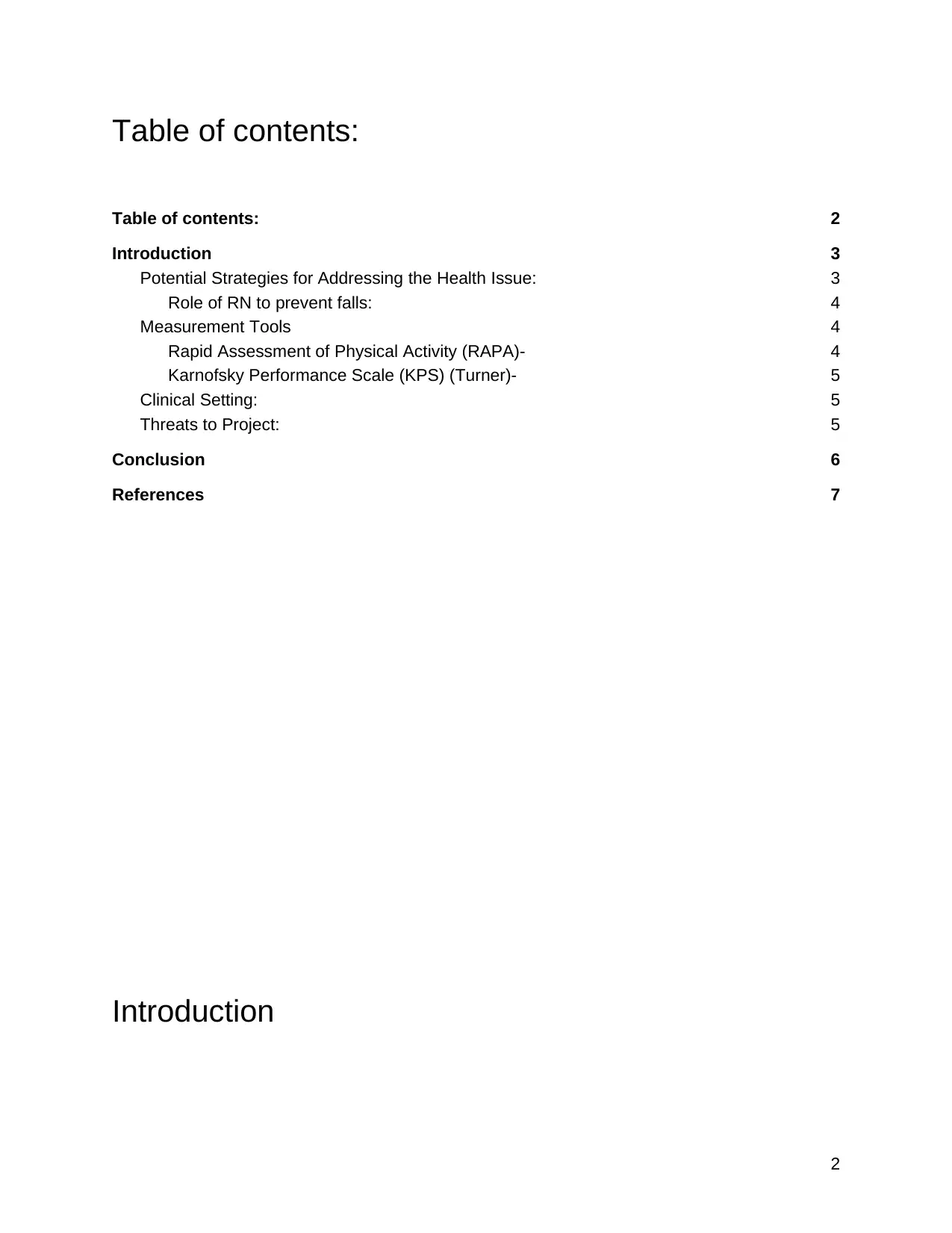
Table of contents:
Table of contents: 2
Introduction 3
Potential Strategies for Addressing the Health Issue: 3
Role of RN to prevent falls: 4
Measurement Tools 4
Rapid Assessment of Physical Activity (RAPA)- 4
Karnofsky Performance Scale (KPS) (Turner)- 5
Clinical Setting: 5
Threats to Project: 5
Conclusion 6
References 7
Introduction
2
Table of contents: 2
Introduction 3
Potential Strategies for Addressing the Health Issue: 3
Role of RN to prevent falls: 4
Measurement Tools 4
Rapid Assessment of Physical Activity (RAPA)- 4
Karnofsky Performance Scale (KPS) (Turner)- 5
Clinical Setting: 5
Threats to Project: 5
Conclusion 6
References 7
Introduction
2
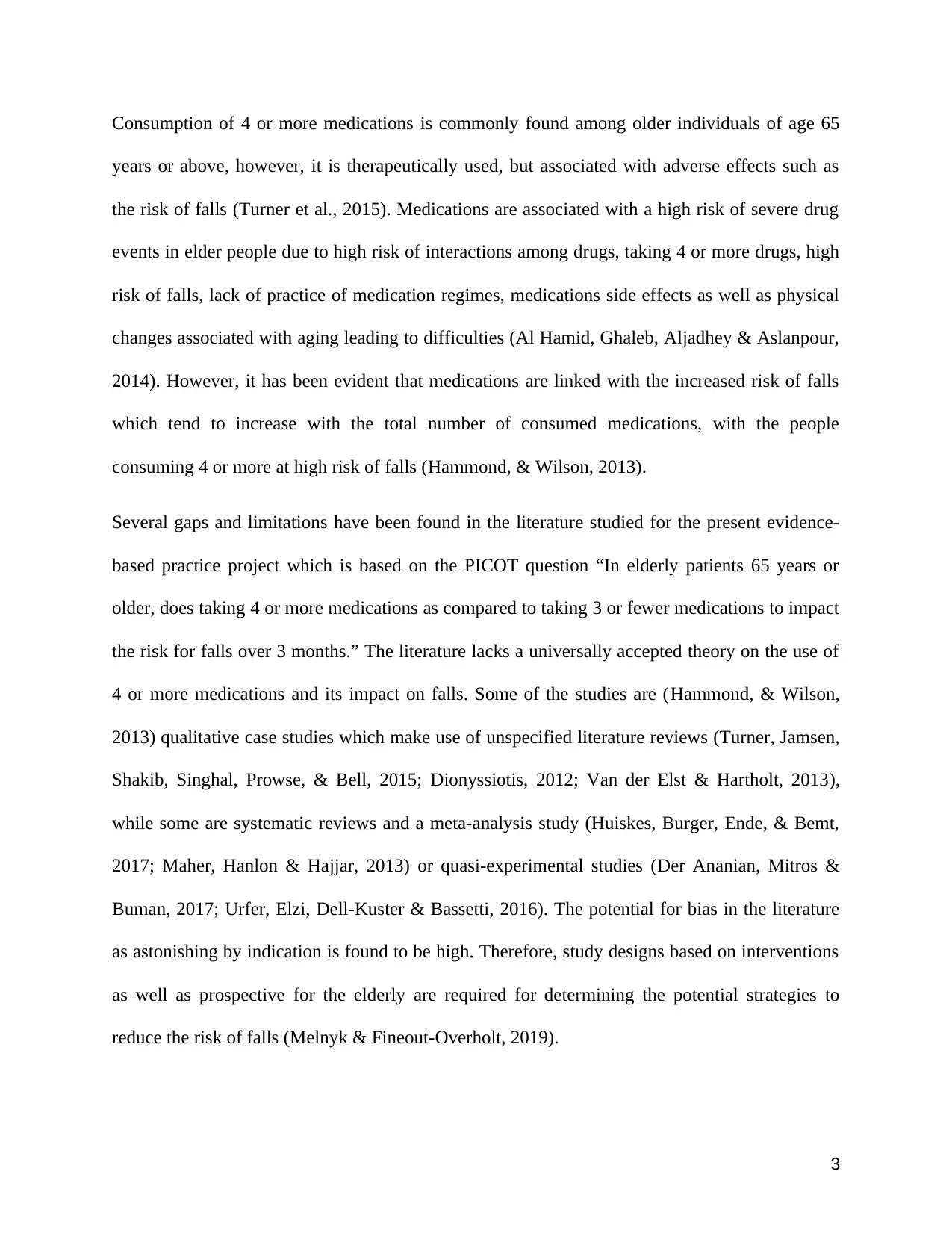
Consumption of 4 or more medications is commonly found among older individuals of age 65
years or above, however, it is therapeutically used, but associated with adverse effects such as
the risk of falls (Turner et al., 2015). Medications are associated with a high risk of severe drug
events in elder people due to high risk of interactions among drugs, taking 4 or more drugs, high
risk of falls, lack of practice of medication regimes, medications side effects as well as physical
changes associated with aging leading to difficulties (Al Hamid, Ghaleb, Aljadhey & Aslanpour,
2014). However, it has been evident that medications are linked with the increased risk of falls
which tend to increase with the total number of consumed medications, with the people
consuming 4 or more at high risk of falls (Hammond, & Wilson, 2013).
Several gaps and limitations have been found in the literature studied for the present evidence-
based practice project which is based on the PICOT question “In elderly patients 65 years or
older, does taking 4 or more medications as compared to taking 3 or fewer medications to impact
the risk for falls over 3 months.” The literature lacks a universally accepted theory on the use of
4 or more medications and its impact on falls. Some of the studies are (Hammond, & Wilson,
2013) qualitative case studies which make use of unspecified literature reviews (Turner, Jamsen,
Shakib, Singhal, Prowse, & Bell, 2015; Dionyssiotis, 2012; Van der Elst & Hartholt, 2013),
while some are systematic reviews and a meta-analysis study (Huiskes, Burger, Ende, & Bemt,
2017; Maher, Hanlon & Hajjar, 2013) or quasi-experimental studies (Der Ananian, Mitros &
Buman, 2017; Urfer, Elzi, Dell-Kuster & Bassetti, 2016). The potential for bias in the literature
as astonishing by indication is found to be high. Therefore, study designs based on interventions
as well as prospective for the elderly are required for determining the potential strategies to
reduce the risk of falls (Melnyk & Fineout-Overholt, 2019).
3
years or above, however, it is therapeutically used, but associated with adverse effects such as
the risk of falls (Turner et al., 2015). Medications are associated with a high risk of severe drug
events in elder people due to high risk of interactions among drugs, taking 4 or more drugs, high
risk of falls, lack of practice of medication regimes, medications side effects as well as physical
changes associated with aging leading to difficulties (Al Hamid, Ghaleb, Aljadhey & Aslanpour,
2014). However, it has been evident that medications are linked with the increased risk of falls
which tend to increase with the total number of consumed medications, with the people
consuming 4 or more at high risk of falls (Hammond, & Wilson, 2013).
Several gaps and limitations have been found in the literature studied for the present evidence-
based practice project which is based on the PICOT question “In elderly patients 65 years or
older, does taking 4 or more medications as compared to taking 3 or fewer medications to impact
the risk for falls over 3 months.” The literature lacks a universally accepted theory on the use of
4 or more medications and its impact on falls. Some of the studies are (Hammond, & Wilson,
2013) qualitative case studies which make use of unspecified literature reviews (Turner, Jamsen,
Shakib, Singhal, Prowse, & Bell, 2015; Dionyssiotis, 2012; Van der Elst & Hartholt, 2013),
while some are systematic reviews and a meta-analysis study (Huiskes, Burger, Ende, & Bemt,
2017; Maher, Hanlon & Hajjar, 2013) or quasi-experimental studies (Der Ananian, Mitros &
Buman, 2017; Urfer, Elzi, Dell-Kuster & Bassetti, 2016). The potential for bias in the literature
as astonishing by indication is found to be high. Therefore, study designs based on interventions
as well as prospective for the elderly are required for determining the potential strategies to
reduce the risk of falls (Melnyk & Fineout-Overholt, 2019).
3
⊘ This is a preview!⊘
Do you want full access?
Subscribe today to unlock all pages.

Trusted by 1+ million students worldwide

Potential Strategies for Addressing the Health Issue:
1. Proper prescription of medication should be assessed with the help of criterion and
judgment based outcome measures (Urfer, Elzi, Dell-Kuster & Bassetti, 2016)
2. The explicit indicators should be avoided as they are unable to address the presence of
diseases among elderly individuals as the prescribing methods differ with different
clinical settings. The implicit strategies might help the RN to obtain useful information
about the patient to make appropriate judgements regarding the use of medications.
(Molist Brunet et al., 2015).
3. The theory of self care deficit helps to particularly state when nursing is required by the
elderly as they are incapable of effective self care. Five methods of helping might be
used as potential strategies such as acting, guiding, teaching and supporting others, and to
provide an adequate environment for the elderly promoting self development (Younas,
2017).
Role of RN to prevent falls:
RN should identify the perceptions of the elderly regarding the causes and role of medications
that lead to falls as well as will to practice change in order to decrease the risk of falls. Strategies
should focus on facilitating behaviour and medication change such as educating them on the
4
1. Proper prescription of medication should be assessed with the help of criterion and
judgment based outcome measures (Urfer, Elzi, Dell-Kuster & Bassetti, 2016)
2. The explicit indicators should be avoided as they are unable to address the presence of
diseases among elderly individuals as the prescribing methods differ with different
clinical settings. The implicit strategies might help the RN to obtain useful information
about the patient to make appropriate judgements regarding the use of medications.
(Molist Brunet et al., 2015).
3. The theory of self care deficit helps to particularly state when nursing is required by the
elderly as they are incapable of effective self care. Five methods of helping might be
used as potential strategies such as acting, guiding, teaching and supporting others, and to
provide an adequate environment for the elderly promoting self development (Younas,
2017).
Role of RN to prevent falls:
RN should identify the perceptions of the elderly regarding the causes and role of medications
that lead to falls as well as will to practice change in order to decrease the risk of falls. Strategies
should focus on facilitating behaviour and medication change such as educating them on the
4
Paraphrase This Document
Need a fresh take? Get an instant paraphrase of this document with our AI Paraphraser
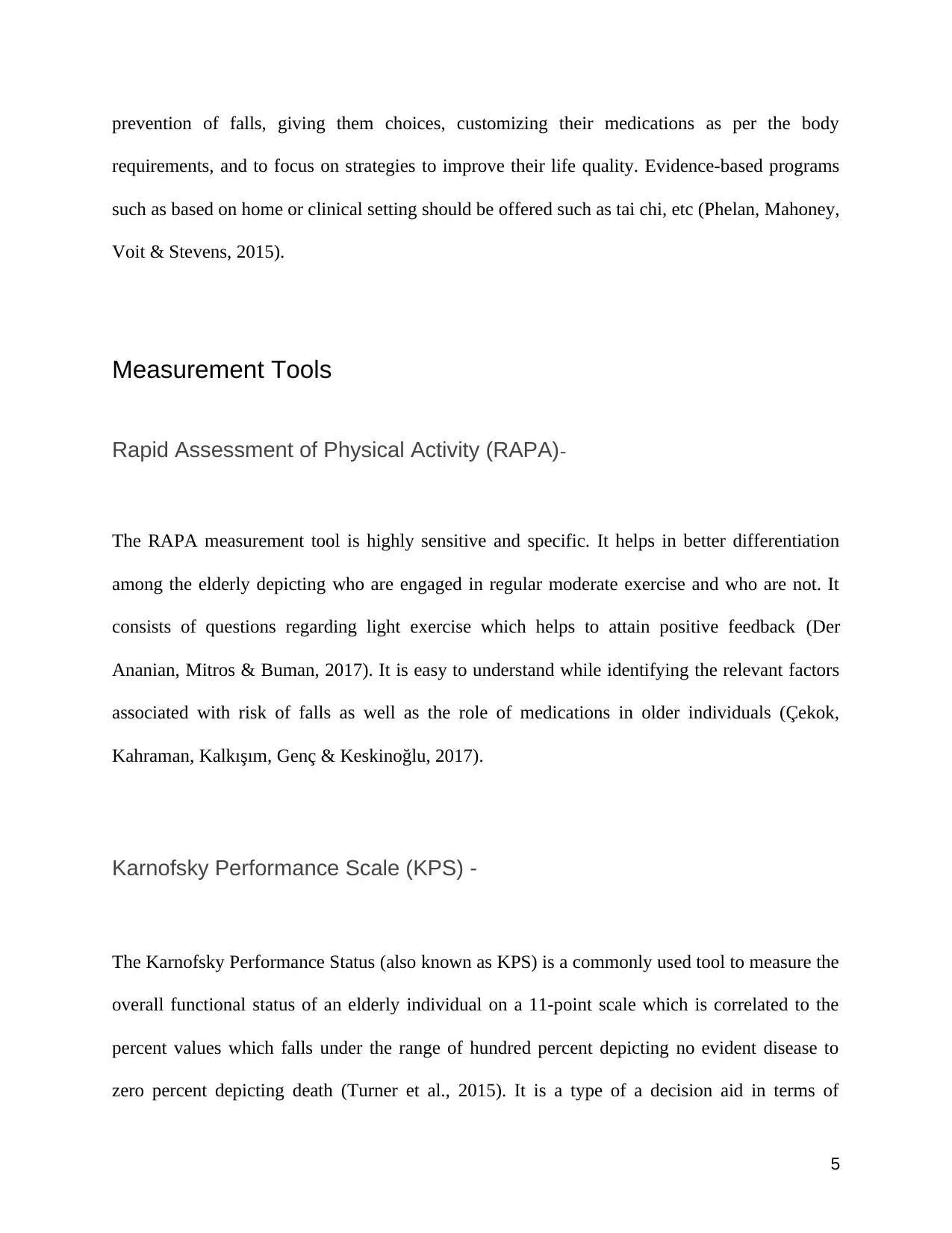
prevention of falls, giving them choices, customizing their medications as per the body
requirements, and to focus on strategies to improve their life quality. Evidence-based programs
such as based on home or clinical setting should be offered such as tai chi, etc (Phelan, Mahoney,
Voit & Stevens, 2015).
Measurement Tools
Rapid Assessment of Physical Activity (RAPA)-
The RAPA measurement tool is highly sensitive and specific. It helps in better differentiation
among the elderly depicting who are engaged in regular moderate exercise and who are not. It
consists of questions regarding light exercise which helps to attain positive feedback (Der
Ananian, Mitros & Buman, 2017). It is easy to understand while identifying the relevant factors
associated with risk of falls as well as the role of medications in older individuals (Çekok,
Kahraman, Kalkışım, Genç & Keskinoğlu, 2017).
Karnofsky Performance Scale (KPS) -
The Karnofsky Performance Status (also known as KPS) is a commonly used tool to measure the
overall functional status of an elderly individual on a 11-point scale which is correlated to the
percent values which falls under the range of hundred percent depicting no evident disease to
zero percent depicting death (Turner et al., 2015). It is a type of a decision aid in terms of
5
requirements, and to focus on strategies to improve their life quality. Evidence-based programs
such as based on home or clinical setting should be offered such as tai chi, etc (Phelan, Mahoney,
Voit & Stevens, 2015).
Measurement Tools
Rapid Assessment of Physical Activity (RAPA)-
The RAPA measurement tool is highly sensitive and specific. It helps in better differentiation
among the elderly depicting who are engaged in regular moderate exercise and who are not. It
consists of questions regarding light exercise which helps to attain positive feedback (Der
Ananian, Mitros & Buman, 2017). It is easy to understand while identifying the relevant factors
associated with risk of falls as well as the role of medications in older individuals (Çekok,
Kahraman, Kalkışım, Genç & Keskinoğlu, 2017).
Karnofsky Performance Scale (KPS) -
The Karnofsky Performance Status (also known as KPS) is a commonly used tool to measure the
overall functional status of an elderly individual on a 11-point scale which is correlated to the
percent values which falls under the range of hundred percent depicting no evident disease to
zero percent depicting death (Turner et al., 2015). It is a type of a decision aid in terms of
5
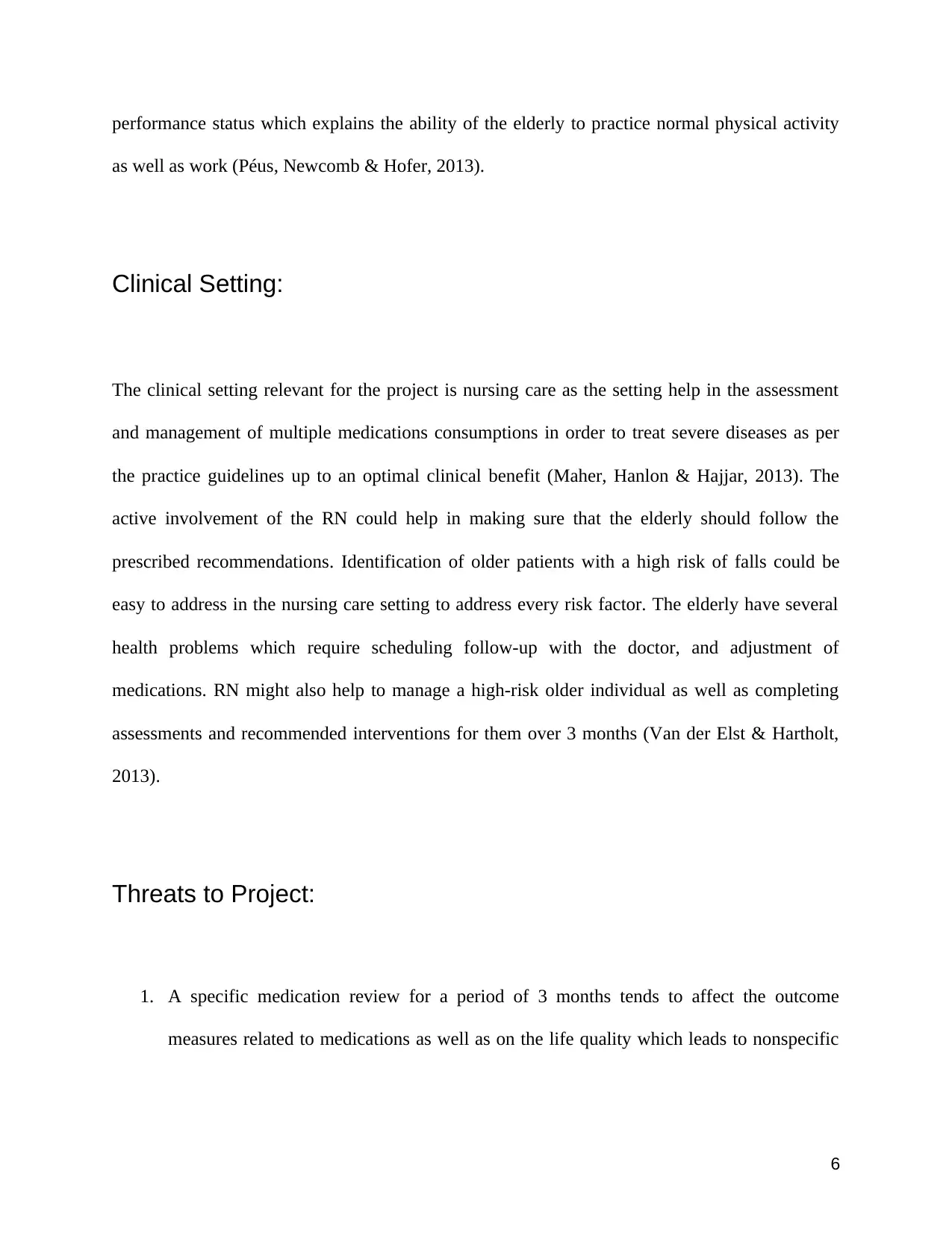
performance status which explains the ability of the elderly to practice normal physical activity
as well as work (Péus, Newcomb & Hofer, 2013).
Clinical Setting:
The clinical setting relevant for the project is nursing care as the setting help in the assessment
and management of multiple medications consumptions in order to treat severe diseases as per
the practice guidelines up to an optimal clinical benefit (Maher, Hanlon & Hajjar, 2013). The
active involvement of the RN could help in making sure that the elderly should follow the
prescribed recommendations. Identification of older patients with a high risk of falls could be
easy to address in the nursing care setting to address every risk factor. The elderly have several
health problems which require scheduling follow-up with the doctor, and adjustment of
medications. RN might also help to manage a high-risk older individual as well as completing
assessments and recommended interventions for them over 3 months (Van der Elst & Hartholt,
2013).
Threats to Project:
1. A specific medication review for a period of 3 months tends to affect the outcome
measures related to medications as well as on the life quality which leads to nonspecific
6
as well as work (Péus, Newcomb & Hofer, 2013).
Clinical Setting:
The clinical setting relevant for the project is nursing care as the setting help in the assessment
and management of multiple medications consumptions in order to treat severe diseases as per
the practice guidelines up to an optimal clinical benefit (Maher, Hanlon & Hajjar, 2013). The
active involvement of the RN could help in making sure that the elderly should follow the
prescribed recommendations. Identification of older patients with a high risk of falls could be
easy to address in the nursing care setting to address every risk factor. The elderly have several
health problems which require scheduling follow-up with the doctor, and adjustment of
medications. RN might also help to manage a high-risk older individual as well as completing
assessments and recommended interventions for them over 3 months (Van der Elst & Hartholt,
2013).
Threats to Project:
1. A specific medication review for a period of 3 months tends to affect the outcome
measures related to medications as well as on the life quality which leads to nonspecific
6
⊘ This is a preview!⊘
Do you want full access?
Subscribe today to unlock all pages.

Trusted by 1+ million students worldwide
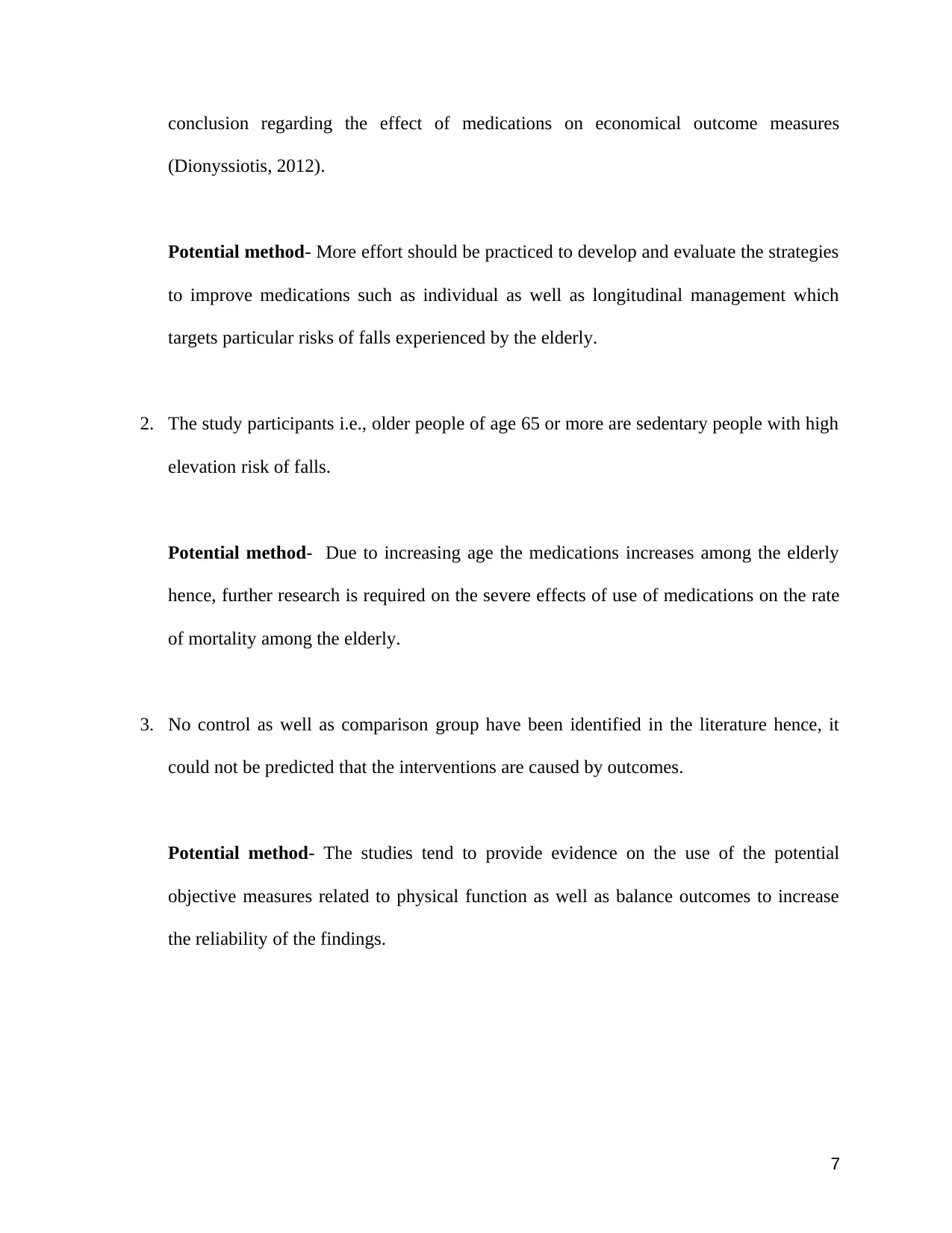
conclusion regarding the effect of medications on economical outcome measures
(Dionyssiotis, 2012).
Potential method- More effort should be practiced to develop and evaluate the strategies
to improve medications such as individual as well as longitudinal management which
targets particular risks of falls experienced by the elderly.
2. The study participants i.e., older people of age 65 or more are sedentary people with high
elevation risk of falls.
Potential method- Due to increasing age the medications increases among the elderly
hence, further research is required on the severe effects of use of medications on the rate
of mortality among the elderly.
3. No control as well as comparison group have been identified in the literature hence, it
could not be predicted that the interventions are caused by outcomes.
Potential method- The studies tend to provide evidence on the use of the potential
objective measures related to physical function as well as balance outcomes to increase
the reliability of the findings.
7
(Dionyssiotis, 2012).
Potential method- More effort should be practiced to develop and evaluate the strategies
to improve medications such as individual as well as longitudinal management which
targets particular risks of falls experienced by the elderly.
2. The study participants i.e., older people of age 65 or more are sedentary people with high
elevation risk of falls.
Potential method- Due to increasing age the medications increases among the elderly
hence, further research is required on the severe effects of use of medications on the rate
of mortality among the elderly.
3. No control as well as comparison group have been identified in the literature hence, it
could not be predicted that the interventions are caused by outcomes.
Potential method- The studies tend to provide evidence on the use of the potential
objective measures related to physical function as well as balance outcomes to increase
the reliability of the findings.
7
Paraphrase This Document
Need a fresh take? Get an instant paraphrase of this document with our AI Paraphraser
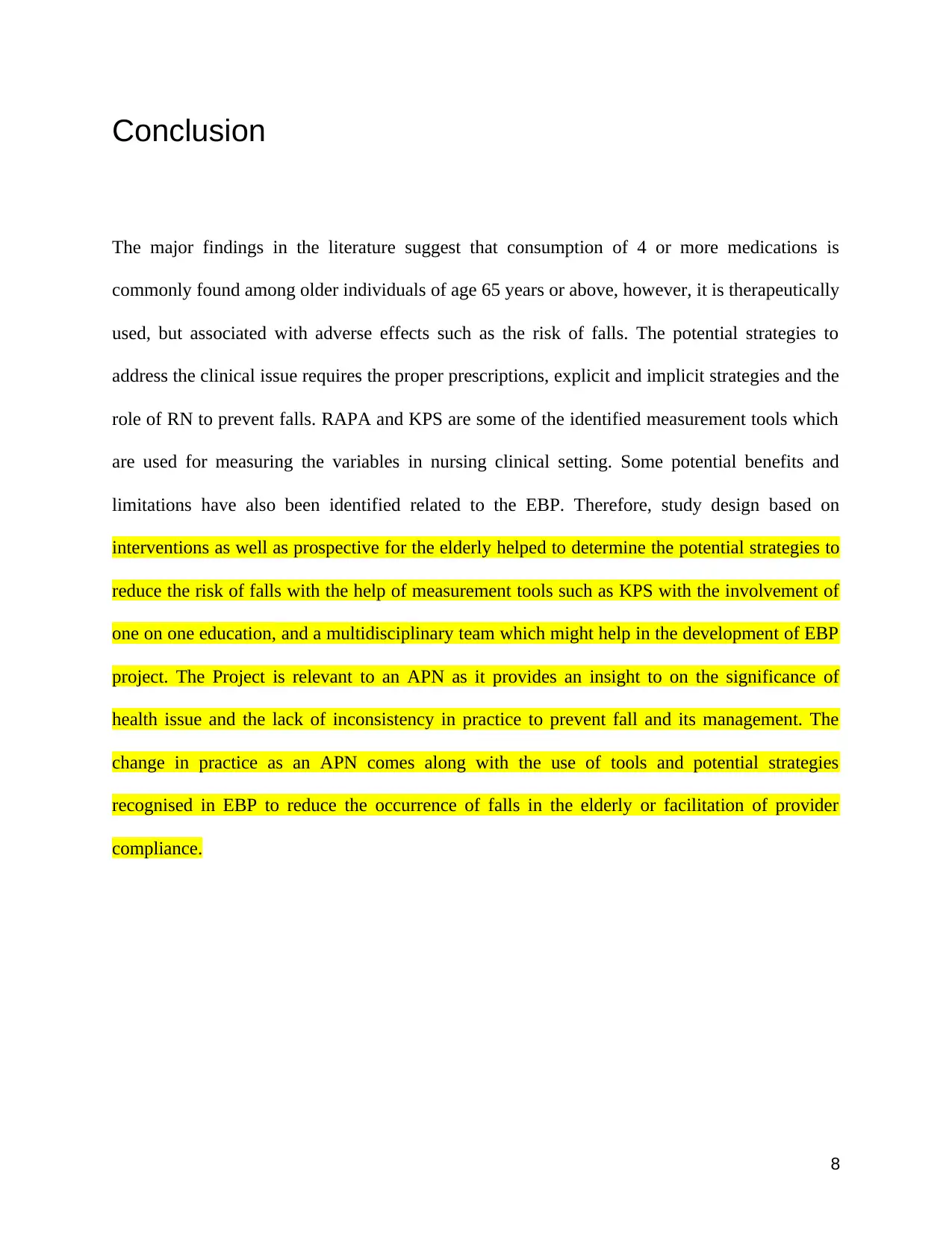
Conclusion
The major findings in the literature suggest that consumption of 4 or more medications is
commonly found among older individuals of age 65 years or above, however, it is therapeutically
used, but associated with adverse effects such as the risk of falls. The potential strategies to
address the clinical issue requires the proper prescriptions, explicit and implicit strategies and the
role of RN to prevent falls. RAPA and KPS are some of the identified measurement tools which
are used for measuring the variables in nursing clinical setting. Some potential benefits and
limitations have also been identified related to the EBP. Therefore, study design based on
interventions as well as prospective for the elderly helped to determine the potential strategies to
reduce the risk of falls with the help of measurement tools such as KPS with the involvement of
one on one education, and a multidisciplinary team which might help in the development of EBP
project. The Project is relevant to an APN as it provides an insight to on the significance of
health issue and the lack of inconsistency in practice to prevent fall and its management. The
change in practice as an APN comes along with the use of tools and potential strategies
recognised in EBP to reduce the occurrence of falls in the elderly or facilitation of provider
compliance.
8
The major findings in the literature suggest that consumption of 4 or more medications is
commonly found among older individuals of age 65 years or above, however, it is therapeutically
used, but associated with adverse effects such as the risk of falls. The potential strategies to
address the clinical issue requires the proper prescriptions, explicit and implicit strategies and the
role of RN to prevent falls. RAPA and KPS are some of the identified measurement tools which
are used for measuring the variables in nursing clinical setting. Some potential benefits and
limitations have also been identified related to the EBP. Therefore, study design based on
interventions as well as prospective for the elderly helped to determine the potential strategies to
reduce the risk of falls with the help of measurement tools such as KPS with the involvement of
one on one education, and a multidisciplinary team which might help in the development of EBP
project. The Project is relevant to an APN as it provides an insight to on the significance of
health issue and the lack of inconsistency in practice to prevent fall and its management. The
change in practice as an APN comes along with the use of tools and potential strategies
recognised in EBP to reduce the occurrence of falls in the elderly or facilitation of provider
compliance.
8
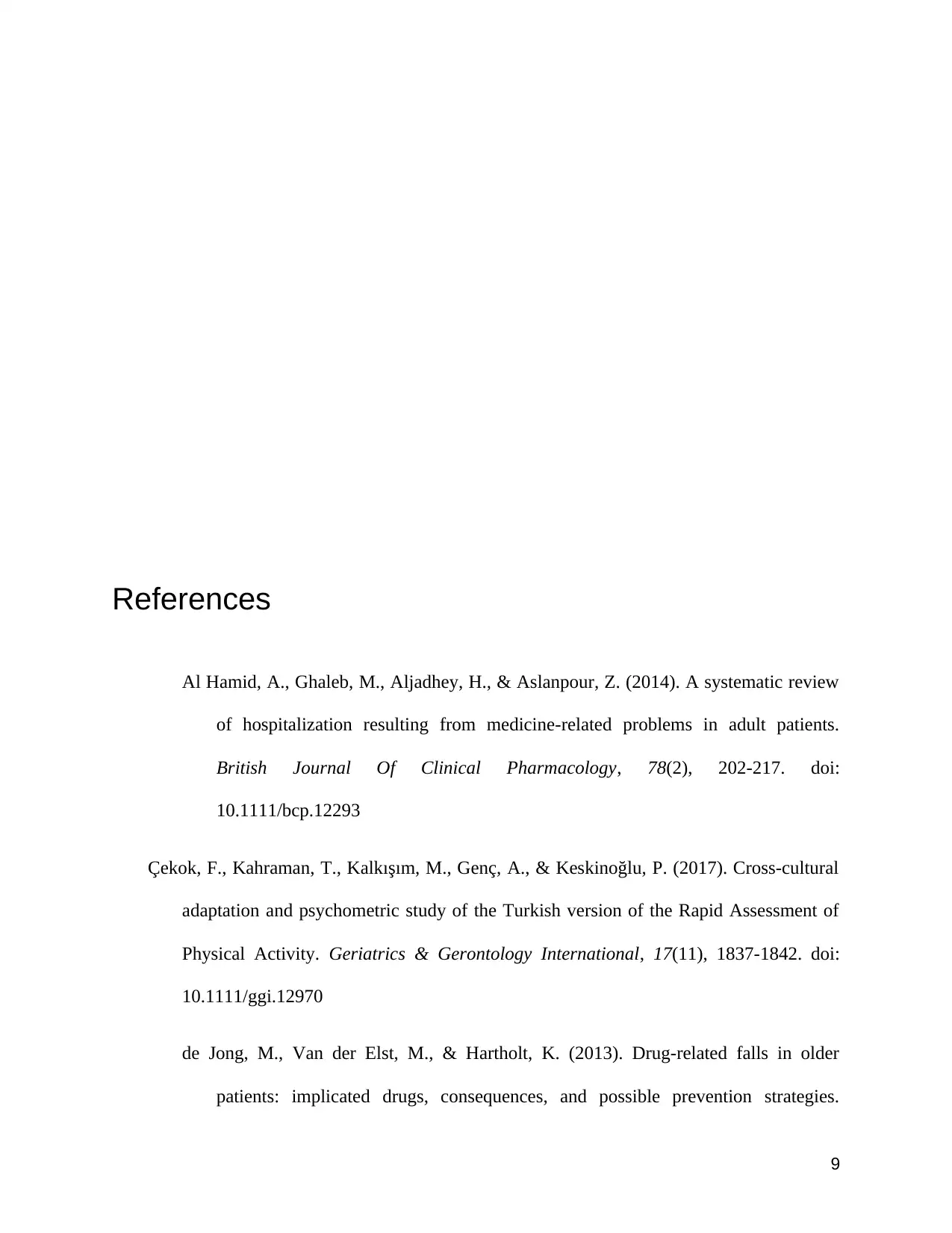
References
Al Hamid, A., Ghaleb, M., Aljadhey, H., & Aslanpour, Z. (2014). A systematic review
of hospitalization resulting from medicine-related problems in adult patients.
British Journal Of Clinical Pharmacology, 78(2), 202-217. doi:
10.1111/bcp.12293
Çekok, F., Kahraman, T., Kalkışım, M., Genç, A., & Keskinoğlu, P. (2017). Cross-cultural
adaptation and psychometric study of the Turkish version of the Rapid Assessment of
Physical Activity. Geriatrics & Gerontology International, 17(11), 1837-1842. doi:
10.1111/ggi.12970
de Jong, M., Van der Elst, M., & Hartholt, K. (2013). Drug-related falls in older
patients: implicated drugs, consequences, and possible prevention strategies.
9
Al Hamid, A., Ghaleb, M., Aljadhey, H., & Aslanpour, Z. (2014). A systematic review
of hospitalization resulting from medicine-related problems in adult patients.
British Journal Of Clinical Pharmacology, 78(2), 202-217. doi:
10.1111/bcp.12293
Çekok, F., Kahraman, T., Kalkışım, M., Genç, A., & Keskinoğlu, P. (2017). Cross-cultural
adaptation and psychometric study of the Turkish version of the Rapid Assessment of
Physical Activity. Geriatrics & Gerontology International, 17(11), 1837-1842. doi:
10.1111/ggi.12970
de Jong, M., Van der Elst, M., & Hartholt, K. (2013). Drug-related falls in older
patients: implicated drugs, consequences, and possible prevention strategies.
9
⊘ This is a preview!⊘
Do you want full access?
Subscribe today to unlock all pages.

Trusted by 1+ million students worldwide
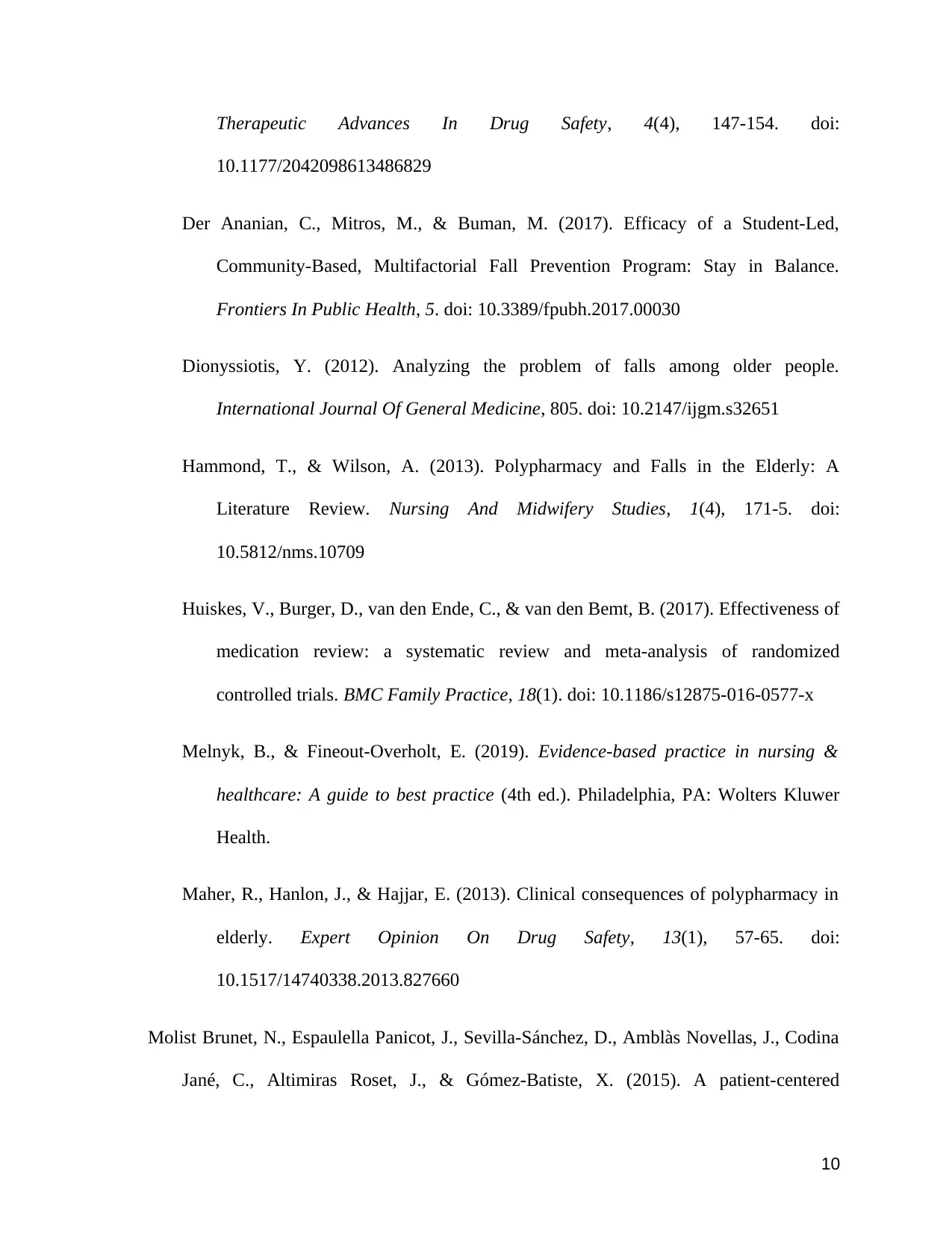
Therapeutic Advances In Drug Safety, 4(4), 147-154. doi:
10.1177/2042098613486829
Der Ananian, C., Mitros, M., & Buman, M. (2017). Efficacy of a Student-Led,
Community-Based, Multifactorial Fall Prevention Program: Stay in Balance.
Frontiers In Public Health, 5. doi: 10.3389/fpubh.2017.00030
Dionyssiotis, Y. (2012). Analyzing the problem of falls among older people.
International Journal Of General Medicine, 805. doi: 10.2147/ijgm.s32651
Hammond, T., & Wilson, A. (2013). Polypharmacy and Falls in the Elderly: A
Literature Review. Nursing And Midwifery Studies, 1(4), 171-5. doi:
10.5812/nms.10709
Huiskes, V., Burger, D., van den Ende, C., & van den Bemt, B. (2017). Effectiveness of
medication review: a systematic review and meta-analysis of randomized
controlled trials. BMC Family Practice, 18(1). doi: 10.1186/s12875-016-0577-x
Melnyk, B., & Fineout-Overholt, E. (2019). Evidence-based practice in nursing &
healthcare: A guide to best practice (4th ed.). Philadelphia, PA: Wolters Kluwer
Health.
Maher, R., Hanlon, J., & Hajjar, E. (2013). Clinical consequences of polypharmacy in
elderly. Expert Opinion On Drug Safety, 13(1), 57-65. doi:
10.1517/14740338.2013.827660
Molist Brunet, N., Espaulella Panicot, J., Sevilla-Sánchez, D., Amblàs Novellas, J., Codina
Jané, C., Altimiras Roset, J., & Gómez-Batiste, X. (2015). A patient-centered
10
10.1177/2042098613486829
Der Ananian, C., Mitros, M., & Buman, M. (2017). Efficacy of a Student-Led,
Community-Based, Multifactorial Fall Prevention Program: Stay in Balance.
Frontiers In Public Health, 5. doi: 10.3389/fpubh.2017.00030
Dionyssiotis, Y. (2012). Analyzing the problem of falls among older people.
International Journal Of General Medicine, 805. doi: 10.2147/ijgm.s32651
Hammond, T., & Wilson, A. (2013). Polypharmacy and Falls in the Elderly: A
Literature Review. Nursing And Midwifery Studies, 1(4), 171-5. doi:
10.5812/nms.10709
Huiskes, V., Burger, D., van den Ende, C., & van den Bemt, B. (2017). Effectiveness of
medication review: a systematic review and meta-analysis of randomized
controlled trials. BMC Family Practice, 18(1). doi: 10.1186/s12875-016-0577-x
Melnyk, B., & Fineout-Overholt, E. (2019). Evidence-based practice in nursing &
healthcare: A guide to best practice (4th ed.). Philadelphia, PA: Wolters Kluwer
Health.
Maher, R., Hanlon, J., & Hajjar, E. (2013). Clinical consequences of polypharmacy in
elderly. Expert Opinion On Drug Safety, 13(1), 57-65. doi:
10.1517/14740338.2013.827660
Molist Brunet, N., Espaulella Panicot, J., Sevilla-Sánchez, D., Amblàs Novellas, J., Codina
Jané, C., Altimiras Roset, J., & Gómez-Batiste, X. (2015). A patient-centered
10
Paraphrase This Document
Need a fresh take? Get an instant paraphrase of this document with our AI Paraphraser
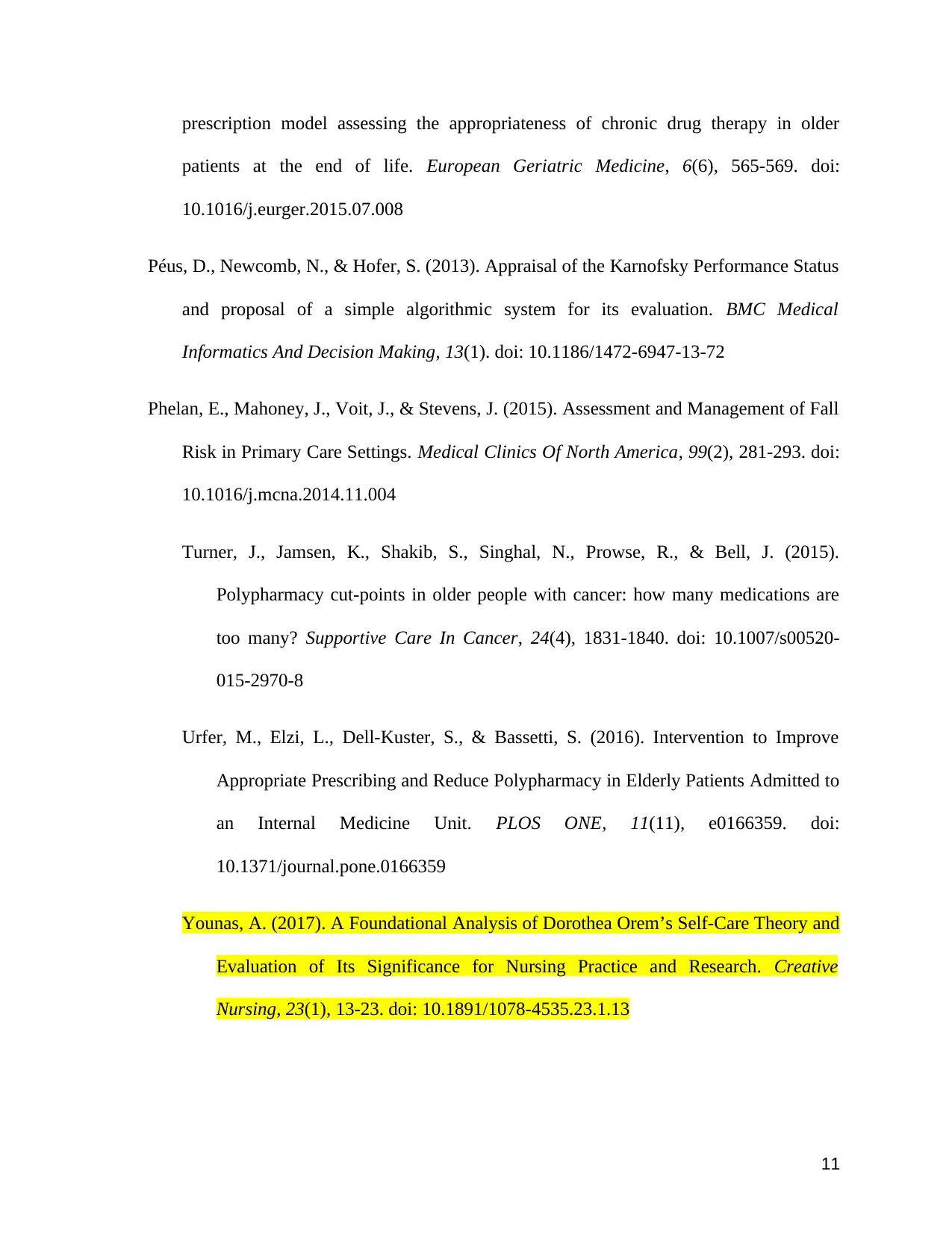
prescription model assessing the appropriateness of chronic drug therapy in older
patients at the end of life. European Geriatric Medicine, 6(6), 565-569. doi:
10.1016/j.eurger.2015.07.008
Péus, D., Newcomb, N., & Hofer, S. (2013). Appraisal of the Karnofsky Performance Status
and proposal of a simple algorithmic system for its evaluation. BMC Medical
Informatics And Decision Making, 13(1). doi: 10.1186/1472-6947-13-72
Phelan, E., Mahoney, J., Voit, J., & Stevens, J. (2015). Assessment and Management of Fall
Risk in Primary Care Settings. Medical Clinics Of North America, 99(2), 281-293. doi:
10.1016/j.mcna.2014.11.004
Turner, J., Jamsen, K., Shakib, S., Singhal, N., Prowse, R., & Bell, J. (2015).
Polypharmacy cut-points in older people with cancer: how many medications are
too many? Supportive Care In Cancer, 24(4), 1831-1840. doi: 10.1007/s00520-
015-2970-8
Urfer, M., Elzi, L., Dell-Kuster, S., & Bassetti, S. (2016). Intervention to Improve
Appropriate Prescribing and Reduce Polypharmacy in Elderly Patients Admitted to
an Internal Medicine Unit. PLOS ONE, 11(11), e0166359. doi:
10.1371/journal.pone.0166359
Younas, A. (2017). A Foundational Analysis of Dorothea Orem’s Self-Care Theory and
Evaluation of Its Significance for Nursing Practice and Research. Creative
Nursing, 23(1), 13-23. doi: 10.1891/1078-4535.23.1.13
11
patients at the end of life. European Geriatric Medicine, 6(6), 565-569. doi:
10.1016/j.eurger.2015.07.008
Péus, D., Newcomb, N., & Hofer, S. (2013). Appraisal of the Karnofsky Performance Status
and proposal of a simple algorithmic system for its evaluation. BMC Medical
Informatics And Decision Making, 13(1). doi: 10.1186/1472-6947-13-72
Phelan, E., Mahoney, J., Voit, J., & Stevens, J. (2015). Assessment and Management of Fall
Risk in Primary Care Settings. Medical Clinics Of North America, 99(2), 281-293. doi:
10.1016/j.mcna.2014.11.004
Turner, J., Jamsen, K., Shakib, S., Singhal, N., Prowse, R., & Bell, J. (2015).
Polypharmacy cut-points in older people with cancer: how many medications are
too many? Supportive Care In Cancer, 24(4), 1831-1840. doi: 10.1007/s00520-
015-2970-8
Urfer, M., Elzi, L., Dell-Kuster, S., & Bassetti, S. (2016). Intervention to Improve
Appropriate Prescribing and Reduce Polypharmacy in Elderly Patients Admitted to
an Internal Medicine Unit. PLOS ONE, 11(11), e0166359. doi:
10.1371/journal.pone.0166359
Younas, A. (2017). A Foundational Analysis of Dorothea Orem’s Self-Care Theory and
Evaluation of Its Significance for Nursing Practice and Research. Creative
Nursing, 23(1), 13-23. doi: 10.1891/1078-4535.23.1.13
11

12
⊘ This is a preview!⊘
Do you want full access?
Subscribe today to unlock all pages.

Trusted by 1+ million students worldwide
1 out of 12
Related Documents
Your All-in-One AI-Powered Toolkit for Academic Success.
+13062052269
info@desklib.com
Available 24*7 on WhatsApp / Email
![[object Object]](/_next/static/media/star-bottom.7253800d.svg)
Unlock your academic potential
Copyright © 2020–2025 A2Z Services. All Rights Reserved. Developed and managed by ZUCOL.




